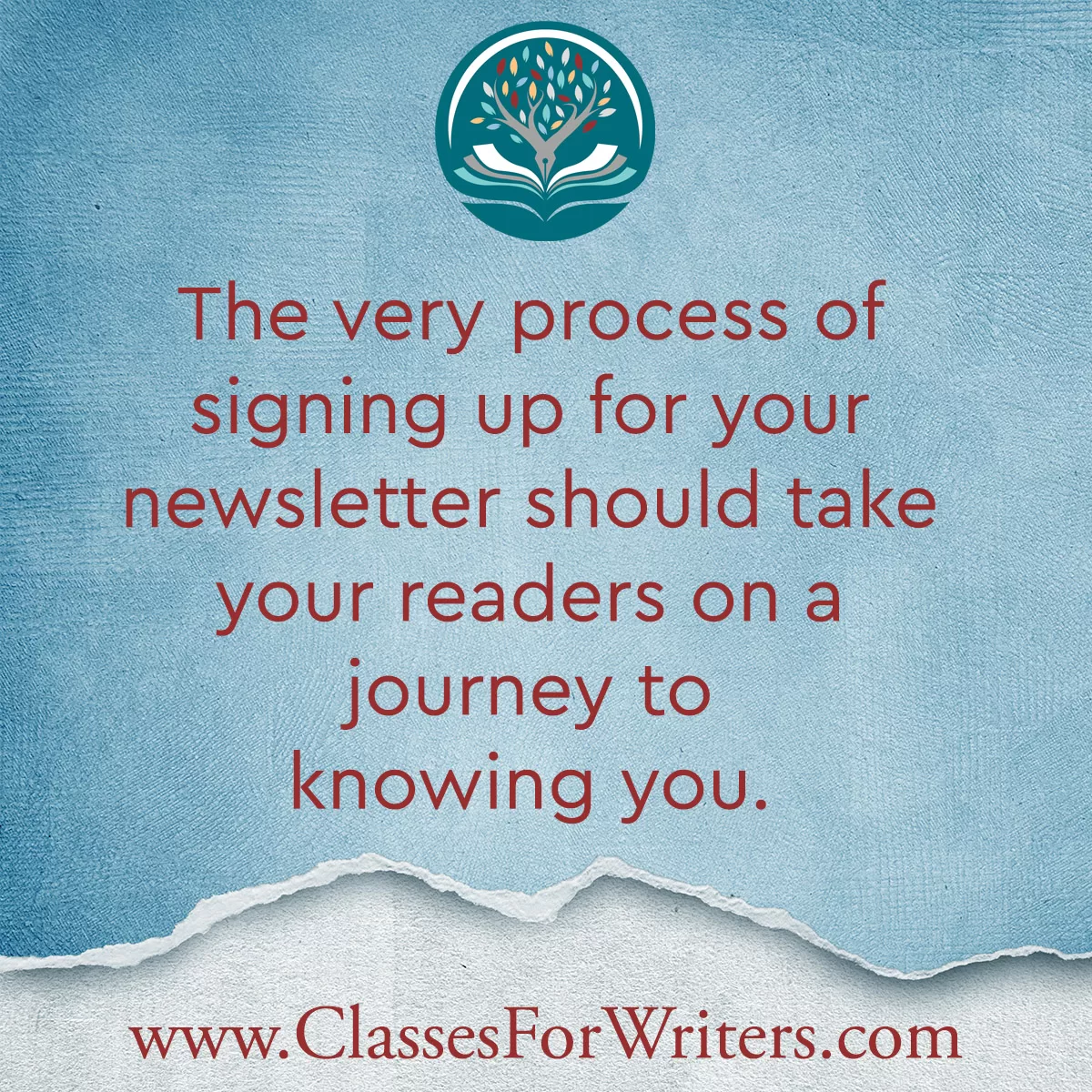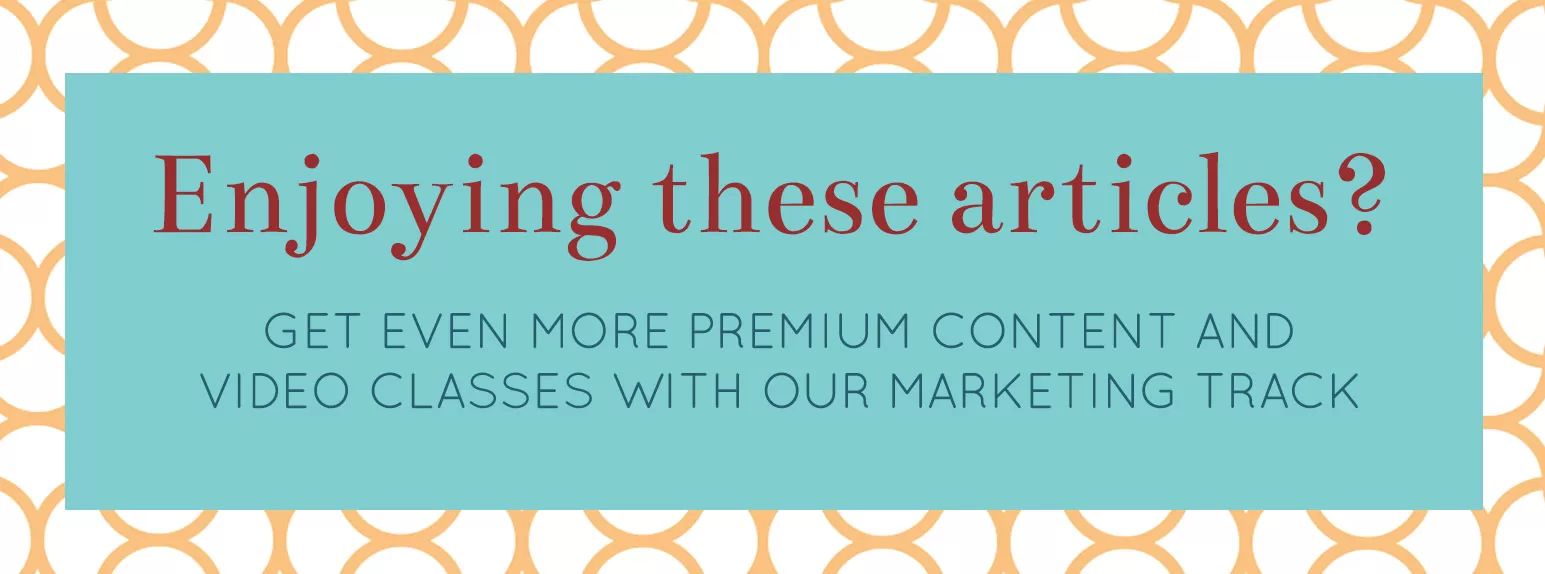Harnessing the Power of Newsletters
for Authors

Do you have a newsletter? And if so, is it working for you like it should?
Newsletters are always a hot topic for authors, primarily because, like with Content Marketing, they’re something all authors are told they need to have.
Maybe you’ve been given this advice in the past, and if so, I want to give you a quick quiz:
- Do you have a mailing list? If you do, this is probably set up on a free service like Mail Chimp, right? If so, so far so good.
- Do you have an opt in on your website? There are so many best practices for this, but to start off, do you have a place on your site that lets people sign up?
- Do you confirm their opt in? When they sign up, do they get something making sure they were the ones that signed up? Protecting your audience from spam is important!
- Then what happens?
- Do they get a welcome email?
- Do they get a welcome sequence?
If you’ve said yes to most of these, congratulations! You’re well on your way to success with newsletters! Some more questions:
- How often do you send an email to your mailing list?
- Once in a while?
- When you have a book or something else to sell
- Annually, Quarterly, or Monthly?
- Weekly? or
- Do you even remember the last time?
Frequency and consistency is one of the most important things you can do when interacting with your audience.
Yes, we’ve all opted into those sales emails that send us stuff so often we have to unsubscribe, but no, you’re not in any danger of being one of those even if you’re sending something every week. In fact, creating regular, expected communication with your audience is key to building your True Fans.

Why Newsletters are Important
Your Audience’s Living Room
Newsletters—emails—are intensely personal. This is why we get so upset when we get spammed. It matters what comes into our personal space. We love to get important personal messages or good news. We hate getting spam or bills or bad news.
But regardless of what it is, it’s all personal. And if someone has opted into getting your newsletter, they’re inviting you into their personal space. They want you there, and you need to honor that.
You Control The Communication
When you send an email to someone, it’s almost collaborative. You control when it goes out, and you control the message. They control when they read it and what to do with it once they have.
I’ve had people ask why they should use a newsletter rather than a website or blog. I always answer that you need to do both, but newsletters allow you to set the agenda. You’re sending your thoughts. This is your chance to remind the audience why they signed up for your newsletter every single time you send one out, and it doesn’t require any effort on their parts.

Goals and Expectations for Your Newsletter
I set high expectations for newsletters. To even get on your mailing list, they have to find you through some means like social media or your website. Probably they found you because of some kind of search. They then have to opt in.
If someone’s gone through all that effort (1.) you owe them something in return, and (2.) they trust you and want to hear from you.
There are lots of statistics out there about how effective newsletters are for things like sales. All I’m going to say here is they’re many times more successful on the whole than social media, so you should be paying at least as much attention to your newsletter as your social media.
When you send out a newsletter you should expect:
- People to open it and click on any links you may have included. If someone’s gone through all the effort we’ve described and you’ve done your job crafting the newsletter, reading it and being interested in what you shared should be a no-brainer.
- People to respond. You should be inviting people to reply to you personally by doing things like asking questions or requesting feedback. Email is designed to foster communication, not to advertise.
- Buying anything you’re letting them know about. There’s no reason that once someone has gotten to the point of joining your newsletter that they wouldn’t buy from you, so don’t hesitate to sell. Just make sure that that’s not all you’re doing.

Using Curated Content in Your Newsletter
There are a few different kinds of content you can share in your newsletter. First, you can write your own content for each and every one. This is what most authors do, and it’s also why most authors fail to continue creating a weekly newsletter. You don’t know what to write about or it just gets to be too much. So it doesn’t get done.
What Is Curated Content and How Do I Use It in My Newsletter?
Curated content is just content you’ve found that was created by someone else and which you felt was useful or important to your readers and subscribers. It takes the form of articles, social media posts, podcasts, videos, or any other kind of content that you might have found that you can link to in an email.
What’s great about curated content is that it’s already made for you, and, as we discussed on other places, it’s a huge act of service in itself. And…curated content gives authors something to write about. If we’re asked to create new content out of thin air, we might not be able to, but if we have inspiration, we’re almost certain to come up with something.
Curation in your newsletter gives you the chance to say something important about that content that’s short and poignant and speaks directly to your readers.
And you can always also curate yourself! If you have articles you’ve written, don’t be afraid to share them to your newsletter along with some notes you might include for why you think it’s important to your subscribers.
You can also use a combination of these. It’s possible—likely even—that you might be inspired to write an article based on something you curated. You can tell the story of that journey for you in your newsletter. There you go! From curation to creating meaningful connection with your subscribers.

Getting People to Sign Up
Getting people to sign up for your newsletter is a balancing act. We’re tempted to think of mailing lists as numbers that have a monetary value. You’ll find lots of articles out there saying that the average newsletter subscriber is worth $X. Resist with everything you have thinking of your audience this way.
Instead, think about each one individually. Everyone on that list is a friend who cares deeply enough about you to solicit your message by opting in.
That means there are things you need to resist in your sign-up messaging, like:
- Coercive popups that force someone to sign up.
- Giving things away for free if they sign up. This one’s always controversial. Here’s my litmus test: if someone’s signing up just to get something for free, that’s probably ultimately counterproductive. Instead consider offering something for free later on that you didn’t advertise in a welcome email or sequence as a means of surprising your subscribers. Nothing creates true fans better than giving something to someone because you value them.
Giving them something to sign up is about you and what you want. Giving them something they didn’t expect is about serving them. - Anything that’s going to affect their user experience on your site. This is probably going to have the opposite effect you’d want by turning off potential fans and getting them to turn their attention elsewhere.
The reason someone signs up for your newsletter is because they want to hear from you—it’s just that simple.
Instead you need to make the opt-in experience:
- Easy. They should be able to tell easily where to sign up and be able to do it with a minimum of effort.
- Let them know what to expect. Your subscribers need to know what they’re getting into. How often will you message them? What will be included? When should they expect it? Once you set these expectations, you need to meet them.
Ultimately the sign-up process should bring your readers on a journey, from discovering you all the way to making them your true fan.
Note: Test Your Tech!
You won’t believe how often people don’t even know when their newsletter opt-in isn’t working. Or their welcome emails aren’t being sent. Or people aren’t getting your emails at all. Test your tech often—monthly is a good practice to make sure everything’s working as you intend. This also gives you a chance to evaluate where you are with your setup.

Evaluating the Success of Your Newsletter
Based on this it should be pretty clear how you evaluate the success of your newsletter. Starting with the sign-up process, are people who find your site also signing up for your newsletter?
Do people respond to your messages—particularly if you ask for feedback?
Do people buy something when you mention something you’re selling?
Do they share the newsletter with others? This one might be harder to judge than others, but some software companies offer a “share this newsletter” link that becomes something you can track.
In the end you want a vibrant newsletter populated with true fans who respond frequently and engage thoughtfully.
If you’re able to do that, your newsletter will become a thriving microcosm of your true fans. Make sure you serve them well!

Goals of Influencer Relationships
In the end, influencer relationships are about creating communities that are of the mutual benefit of all. That includes you, the other influencers, and your fans and audience. With everyone amplifying each other, it’s a relationship that everyone benefits from and everyone is willing to continue to pour more effort into building.
Ultimately you will want to create relationships with at least 10 different influencers. Some will be willing to come into community with you and others. Others will be more defensive and see other influencers as competitors. Know which are which and don’t force anything that doesn’t work.
Even if all your relationships with influencers are between you and them and not as a group, you’re the one building a community by connecting your fans to others who they might also be interested in. You can become the hub of your fans’ lives.
Becoming an Influencer Yourself
One of the things that’ll happen as you go through this process is that you become an influencer yourself. If you’re very successful, you might become the de facto leader in your “niche” and be the person everyone in it goes to for the best content, whether that’s what you create, your books, or what you curate and share from others.
Combining connecting with influencers and other strategies like content marketing will build you a platform from which you can sell books and any other products you might create. But first, and foremost, it forms the foundation from which you can start building the world you want to live in and be a part of every single day. It can create financial success, but it can also more importantly create fulfillment even while you’re still struggling to get there.

